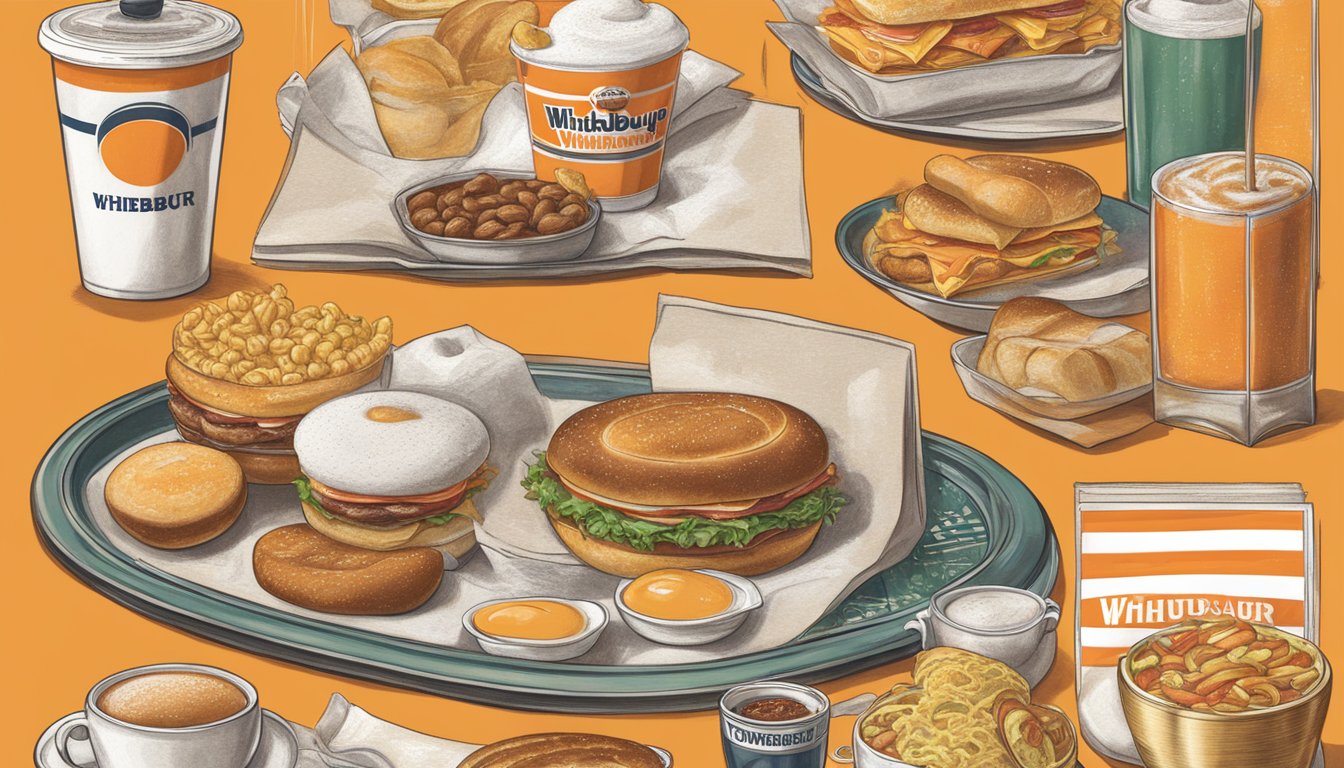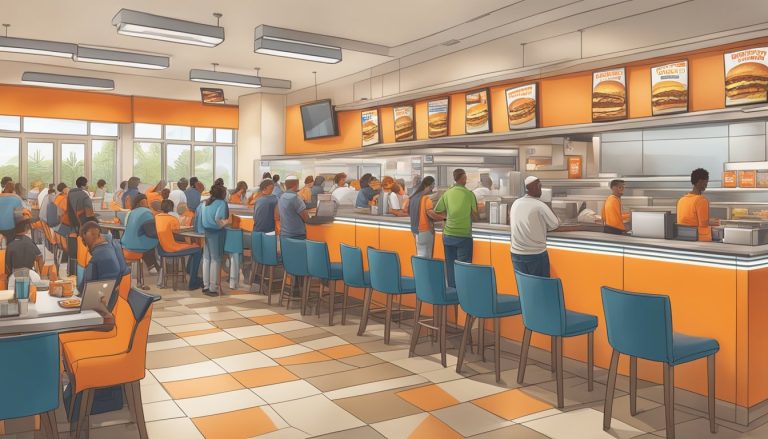Whataburger’s breakfast menu has been a beloved part of the Texas-based chain since its introduction. The iconic orange-and-white striped restaurants have served up morning favorites to hungry customers for decades. Whataburger’s breakfast pricing has evolved over time, with current options ranging from $2 to $5 for most items.
The company’s journey with breakfast began years after Harmon Dobson opened the first Whataburger in Corpus Christi, Texas in 1950. As the chain expanded, so did its menu offerings. Whataburger adapted to changing consumer tastes and economic conditions, adjusting its breakfast hours and prices accordingly.
In 2015, Whataburger faced challenges when an egg shortage forced the company to limit its breakfast hours temporarily. This event highlighted the delicate balance between supply costs and menu pricing. Despite such hurdles, Whataburger has maintained competitive breakfast prices while continuing to serve quality morning meals that keep customers coming back.
The Beginnings of Whataburger

Whataburger’s origin story is rooted in one man’s vision and a single burger stand in Corpus Christi, Texas. The company’s humble beginnings laid the foundation for a fast-food empire that would reshape the industry.
Harmon Dobson’s Vision
Harmon Dobson, a passionate entrepreneur, dreamed of creating a burger so big it would take two hands to hold. In 1950, he put this vision into action. Dobson believed in quality ingredients and generous portions, setting Whataburger apart from competitors.
His goal was simple yet ambitious: make a burger so good, customers would exclaim “What a burger!” This catchphrase became the inspiration for the restaurant’s name.
The First Restaurant in Corpus Christi
On August 8, 1950, Dobson opened the first Whataburger in Corpus Christi. The initial location was a modest portable building on Ayers Street. It featured an open-air concept with no indoor seating.
The stand quickly gained popularity among locals. Dobson’s commitment to fresh, made-to-order burgers resonated with customers. This success led to rapid expansion within Texas.
Whataburger’s Early Menu
Whataburger’s initial menu was straightforward, focusing on burgers, drinks, and chips. The signature item was a quarter-pound beef patty on a 5-inch bun, priced at 35 cents.
Key features of the early menu:
- 100% pure beef patties
- Large, toasted buns
- Fresh vegetables
- Made-to-order customization
As demand grew, Whataburger gradually expanded its offerings. The company maintained its focus on quality ingredients and generous portions, establishing a loyal customer base.
Expansion and Brand Identity

Whataburger’s growth from a single Texas location to a beloved Southern fast-food chain is closely tied to its distinctive brand identity. The company’s expansion strategy and iconic building design have played crucial roles in its success.
From Texas to the Southern United States
Whataburger began its expansion beyond Texas in the 1960s. The company strategically entered new markets in neighboring states, maintaining its commitment to quality and customer service. By 2025, Whataburger operates in 10 Southern states, with 828 locations. Texas remains the brand’s stronghold, hosting 600 of its restaurants.
Franchising has been a key driver of Whataburger’s growth. The company carefully selects franchise partners who align with its values and standards. This approach has allowed Whataburger to expand while preserving its brand identity and food quality.
A-Frame Buildings and Trademark Design
Whataburger’s distinctive A-frame buildings have become a trademark of the brand. Introduced in the 1960s, these structures feature a steep orange and white striped roof that makes them instantly recognizable.
The A-frame design serves both practical and marketing purposes. It provides ample visibility from a distance, acting as a beacon for hungry customers. The orange and white color scheme further reinforces brand recognition.
In recent years, Whataburger has updated its building designs while retaining key elements of its iconic look. Modern locations often incorporate the signature colors and angular shapes in more contemporary structures, maintaining brand continuity.
Introduction of Breakfast and Menu Evolution

Whataburger’s breakfast menu transformed the fast food landscape in Texas and beyond. The company expanded its offerings from burgers to morning favorites, satisfying customers around the clock with innovative items.
Breakfast Debut and Initial Offerings
Whataburger introduced its breakfast menu in 1979, marking a significant expansion of its product line. The initial breakfast offerings included simple yet satisfying items like biscuits and egg sandwiches. The Breakfast on a Bun became an instant hit, featuring a fresh egg, choice of bacon or sausage, and cheese on a toasted bun.
Prices for breakfast items ranged from about $1 for basic biscuits to around $5 for more substantial options. This pricing strategy made Whataburger’s breakfast accessible to a wide range of customers.
Innovations in Breakfast Items
As the breakfast menu evolved, Whataburger introduced more innovative items. The Honey Butter Chicken Biscuit emerged as a fan favorite, combining sweet and savory flavors. The Taquito with Cheese offered a Tex-Mex twist on breakfast.
Whataburger also developed heartier options like the Breakfast Platter, which included scrambled eggs, hash browns, and a choice of meat. The Breakfast Burger bridged the gap between traditional breakfast and lunch offerings.
These creative menu additions helped Whataburger stand out in the competitive fast food breakfast market. The company’s willingness to experiment with flavors and textures kept customers coming back for new taste experiences.
Pricing Strategies Over the Years

Whataburger’s breakfast pricing has evolved significantly since its introduction. The chain has adapted to economic shifts and supply chain challenges while maintaining its commitment to quality ingredients.
Economic Factors Affecting Prices
Whataburger’s breakfast pricing has been influenced by various economic factors over the years. Inflation rates and changes in consumer spending habits have played crucial roles. During economic downturns, the company has strategically adjusted prices to remain competitive while preserving profit margins.
Whataburger has also implemented promotional pricing tactics to drive sales. These have included limited-time offers and combo meal deals, which have helped attract budget-conscious customers without compromising on quality.
The Role of Supply Chain and Ingredients Cost
The cost of key breakfast ingredients has directly impacted Whataburger’s pricing strategies. Fluctuations in the prices of eggs, bacon, and beef have required careful management to maintain profitability.
Whataburger has invested in efficient supply chain processes to mitigate cost increases. This has allowed them to keep prices relatively stable for popular items like breakfast taquitos and biscuit sandwiches.
The company has also focused on strategic partnerships with suppliers to secure favorable pricing for high-quality ingredients. This approach has helped Whataburger balance its commitment to fresh, tasty breakfast offerings with the need to maintain competitive prices in the fast-food market.
Operational Growth

Whataburger’s operational expansion focused on enhancing customer experience and solidifying its brand identity. The company implemented key strategies to increase efficiency and reach while maintaining its signature quality.
Drive-Thru Revolution and Customer Satisfaction
Whataburger embraced the drive-thru concept early on, recognizing its potential to serve customers quickly. This innovation significantly boosted sales and improved accessibility.
The company invested in streamlining drive-thru operations, reducing wait times and enhancing order accuracy. Whataburger also introduced dual drive-thru lanes at busy locations to manage high traffic volumes.
Customer satisfaction remained a top priority. The chain implemented rigorous training programs for staff to ensure consistent food quality and friendly service across all locations.
Becoming a Texas Treasure and National Franchise
Whataburger’s roots in Texas shaped its growth strategy. The company expanded methodically, focusing on building a strong presence in its home state before venturing outward.
By 1967, Whataburger had grown to 40 locations across four states. This careful expansion allowed the chain to maintain quality control and preserve its unique culture.
Whataburger’s commitment to local flavors and Texas-sized portions earned it a devoted following. The company became a cultural icon in Texas, with many considering it a state treasure.
As Whataburger expanded nationally, it adapted its menu to include regional preferences while keeping its core offerings intact. This approach helped the chain maintain its identity while appealing to new markets.
Ownership and Corporate Direction

Whataburger’s ownership and leadership have evolved significantly since its founding, shaping the company’s growth and direction. Key transitions in ownership and strategic decisions by CEOs have propelled Whataburger’s expansion while maintaining its core values.
Dobson Family and BDT Capital Partners
The Dobson family owned and operated Whataburger for nearly seven decades after Harmon Dobson founded the company in 1950. Under their guidance, Whataburger grew from a single Corpus Christi location to a beloved regional chain.
In 2019, the Dobson family sold their majority stake to BDT Capital Partners, a Chicago-based investment firm. This marked a pivotal shift in ownership structure while preserving Whataburger’s Texas roots.
The Dobsons retained a minority stake, ensuring continuity of the family’s influence. BDT’s acquisition aimed to provide resources for accelerated growth and innovation.
Evolving Leadership and CEO Contributions
Whataburger’s CEOs have played crucial roles in steering the company’s direction. Tom Dobson, son of founder Harmon Dobson, served as CEO until 2014.
Preston Atkinson took over as CEO in 2014, focusing on menu innovation and technology integration. Ed Nelson became CEO in 2020, emphasizing digital transformation and market expansion.
Under Nelson’s leadership, Whataburger has pursued aggressive growth strategies. The company has expanded into new states and invested in restaurant redesigns.
Whataburger’s headquarters remain in San Antonio, Texas, maintaining strong ties to its home state. Recent corporate initiatives have focused on modernizing operations while preserving the brand’s iconic status.
Marketing and Customer Engagement

Whataburger’s marketing efforts focus on building brand loyalty and connecting with local communities. The company leverages its Texas roots and distinctive orange-and-white color scheme to create a memorable identity.
Advertising Campaigns and Building a Brand Voice
Whataburger’s advertising campaigns emphasize quality, freshness, and customization. The company’s tagline “What-a-burger!” has become iconic, reinforcing brand recognition. Television commercials often feature loyal customers sharing their favorite menu items.
Print ads and billboards showcase mouthwatering images of burgers and breakfast items. The brand’s social media presence is active and engaging, with witty posts that resonate with younger audiences.
Whataburger’s marketing strategy includes seasonal promotions and limited-time offers for breakfast items. These campaigns generate excitement and drive traffic during morning hours.
Customer Loyalty and Community Connections
Whataburger fosters customer loyalty through its “Whataburger Family” rewards program. Members earn points on purchases and receive exclusive offers, including breakfast deals.
The company sponsors local events and sports teams, strengthening its ties to Texas communities. Whataburger’s charitable initiatives, such as the Whataburger Feeding Student Success program, support education and hunger relief.
Customized merchandise, like the popular “Fancy Ketchup” packets, allows fans to show their brand affinity. Whataburger’s commitment to serving made-to-order food 24/7 has built a loyal following among late-night and early-morning customers.
The brand’s Texas heritage remains a key selling point, appealing to locals and tourists alike seeking an authentic Texan dining experience.
Looking to the Future

Whataburger’s breakfast pricing strategy is set to evolve alongside industry trends and consumer preferences. The company plans to balance innovation with its commitment to value.
Innovation and Menu Expansion
Whataburger aims to introduce new breakfast items that cater to changing tastes. The chain is exploring healthier options and unique flavor combinations to attract a broader customer base. Plant-based alternatives may join the menu, appealing to vegetarian and flexitarian diners.
Technological advancements will likely impact ordering and pricing. Mobile apps and digital kiosks could offer personalized deals and dynamic pricing based on demand. This approach may help Whataburger optimize its breakfast pricing structure.
Regional specialties might appear on menus in different areas, allowing for localized pricing strategies. These additions could reflect local tastes while maintaining the core breakfast offerings customers expect.
Continued Commitment to Quality and Value
Whataburger plans to maintain its reputation for quality ingredients despite potential cost pressures. The company may invest in supply chain efficiencies to keep prices competitive without compromising on taste or portion sizes.
Value meals and combo options will likely remain a key part of the breakfast menu. These bundles offer customers savings while encouraging higher overall spending. Whataburger might introduce tiered pricing options, giving customers more choice in how they build their breakfast.
Seasonal promotions and limited-time offers could become more frequent. These specials would create excitement and drive traffic during slower periods. The chain may also explore subscription models for regular customers, offering discounts on daily breakfast purchases.




